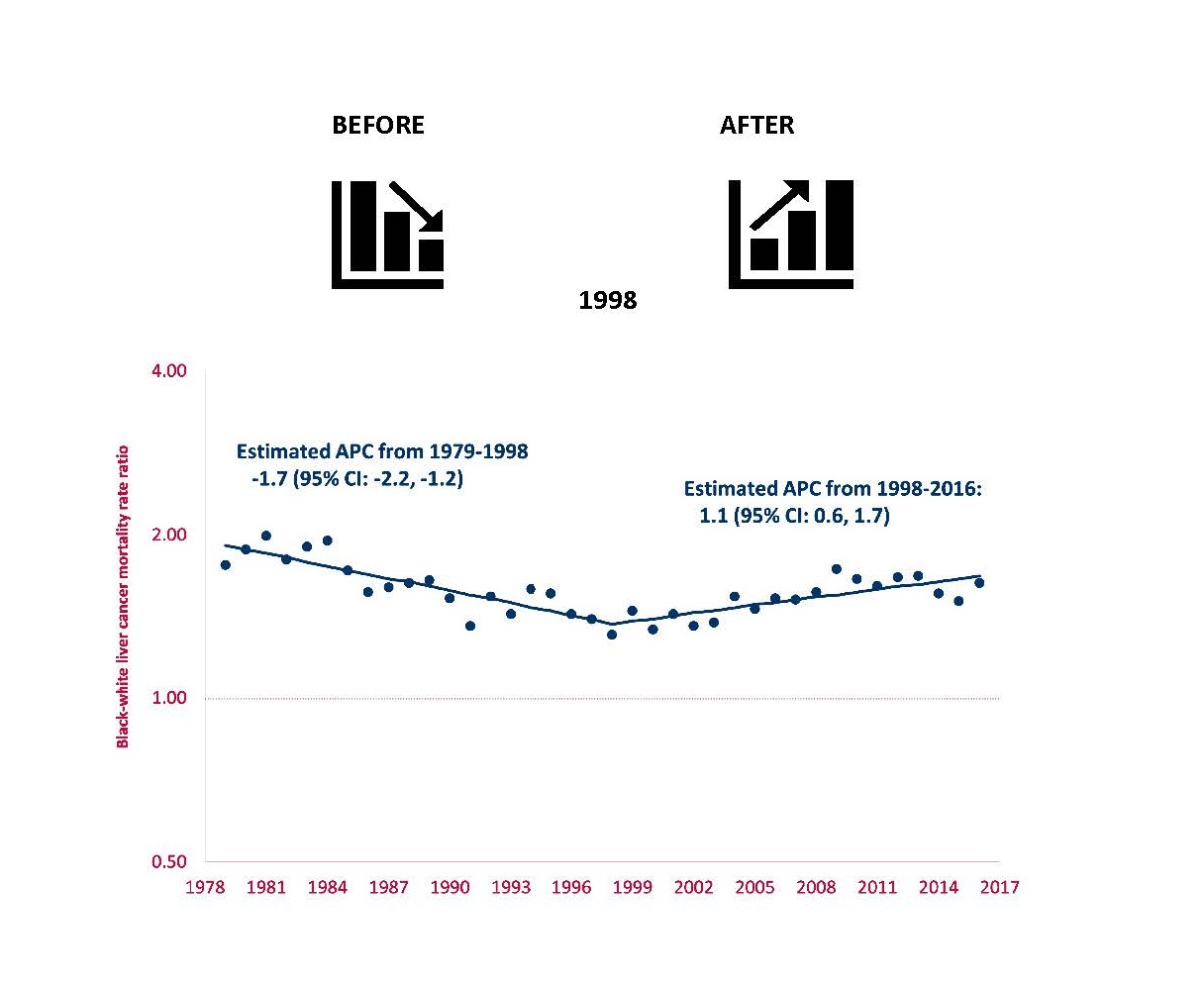Researchers from Florida Atlantic University’s Schmidt College of Medicine and Baylor College of Medicine explored racial inequalities in mortality from liver cancer before and after the introduction of lifesaving drugs for hepatitis C virus in the U.S.
Results of the study, just published in EClinical Medicine, showed that from 1979 to 1998, racial inequalities in mortality from liver cancer in the U.S. were declining, but, from 1998 to 2016, racial inequalities steadily increased. From 1998 to 2016, of the 16,770 deaths from liver cancer among blacks, the excess relative to whites increased from 27.8 percent to 45.4 percent, and the trends were more prominent in men. Concurrently, racial inequalities in mortality decreased for major risk factors for liver cancer, including alcohol, obesity and diabetes.
The rate among blacks increased from 9.4 per 100,000 in 1998 to 16.7 per 100,000 in 2016, an increase of 77.7 percent, while the corresponding values for whites were 7.2 to 10.3, an increase of 43.1 percent. Rates among blacks age 55 and older increased by 1.7 percent per year from 1979 to 1997 and by 4.2 percent per year from 2000 to 2016. In contrast, corresponding rates among whites increased by 3.5 percent per year from 1979 to 1990, and then increased by 2 percent per year from 1990 to 2016.
“We observed steady increases in racial inequalities in mortality from liver cancer after the licensure of lifesaving drugs for hepatitis C virus in the United States,” said Charles H. Hennekens, M.D., Dr.PH, senior author, and the first Sir Richard Doll Professor and senior academic advisor in FAU’s Schmidt College of Medicine, and an adjunct professor at Baylor College of Medicine.
Robert S. Levine, M.D., professor of family and community medicine at Baylor College of Medicine and an affiliate professor at FAU’s Schmidt College of Medicine, was first author. Hennekens and Levine have collaborated on numerous peer-reviewed manuscripts for nearly five decades and previously noted similar increases in racial inequalities in mortalities from HIV and RDS following the introduction of lifesaving drugs.
The authors note that these descriptive data are useful to formulate but not test hypotheses. Among the many plausible hypotheses generated from these observations are social side effects, including unequal accessibility, acceptability and/or utilization of health care.
“A major clinical and public health priority should be to decrease racial inequalities in mortality following the introduction of lifesaving drugs in the United States and worldwide,” said Hennekens.
Data for the study derived from the U.S. Centers for Disease Control and Prevention Wide-ranging ONline Data for Epidemiologic Research (WONDER) to describe liver cancer mortality rates from 1979 to 2016 in those 55 years of age and older, because they suffer the largest disease burden.
In the U.S., with respect to liver cancer, more than 3 million people are affected and about 17,000 new cases occur each year. Hepatitis C virus is estimated to result in 30,160 deaths (20,020 in men and 10,140 in women) this year alone. For men, liver cancer is the fifth most common cause of cancer deaths and for women, it is the seventh leading cause of cancer deaths. The overall death rate from liver cancer has more than doubled from 1980 to 2017.
Study co-authors are Maria C. Mejia, M.D., M.S.P.H.; Jason L. Salemi, Ph.D.; Sandra J. Gonzalez, Ph.D.; Muktar H. Aliyu, M.D., M.P.H., Dr.P.H.; Baqar A. Husaini, Ph.D.; and Roger J. Zoorob, M.D., M.P.H., all with Baylor College of Medicine.
– FAU –
About the Charles E. Schmidt College of Medicine:
FAU’s Charles E. Schmidt College of Medicine is one of approximately 152 accredited medical schools in the U.S. The college was launched in 2010, when the Florida Board of Governors made a landmark decision authorizing FAU to award the M.D. degree. After receiving approval from the Florida legislature and the governor, it became the 134th allopathic medical school in North America. With more than 70 full and part-time faculty and more than 1,300 affiliate faculty, the college matriculates 64 medical students each year and has been nationally recognized for its innovative curriculum. To further FAU’s commitment to increase much needed medical residency positions in Palm Beach County and to ensure that the region will continue to have an adequate and well-trained physician workforce, the FAU Charles E. Schmidt College of Medicine Consortium for Graduate Medical Education (GME) was formed in fall 2011 with five leading hospitals in Palm Beach County. The Consortium currently has five Accreditation Council for Graduate Medical Education (ACGME) accredited residencies including internal medicine, surgery, emergency medicine, psychiatry, and neurology.
About Florida Atlantic University:
Florida Atlantic University, established in 1961, officially opened its doors in 1964 as the fifth public university in Florida. Today, the University, with an annual economic impact of $6.3 billion, serves more than 30,000 undergraduate and graduate students at sites throughout its six-county service region in southeast Florida. FAU’s world-class teaching and research faculty serves students through 10 colleges: the Dorothy F. Schmidt College of Arts and Letters, the College of Business, the College for Design and Social Inquiry, the College of Education, the College of Engineering and Computer Science, the Graduate College, the Harriet L. Wilkes Honors College, the Charles E. Schmidt College of Medicine, the Christine E. Lynn College of Nursing and the Charles E. Schmidt College of Science. FAU is ranked as a High Research Activity institution by the Carnegie Foundation for the Advancement of Teaching. The University is placing special focus on the rapid development of three signature themes – marine and coastal issues, biotechnology and contemporary societal challenges – which provide opportunities for faculty and students to build upon FAU’s existing strengths in research and scholarship. For more information, visit www.fau.edu.
Original post https://alertarticles.info


